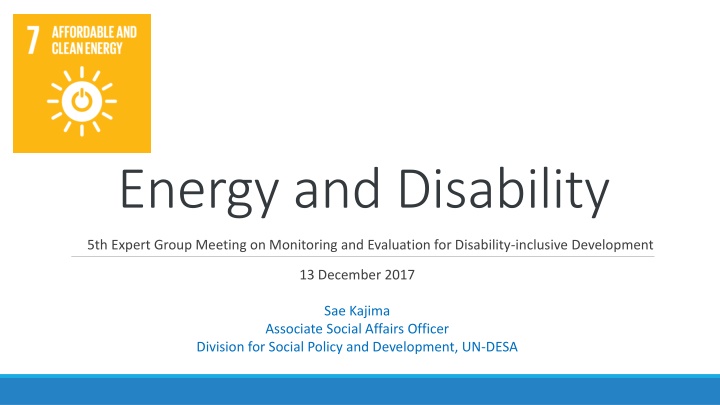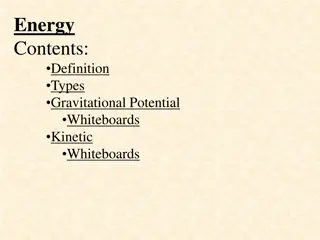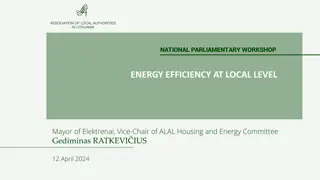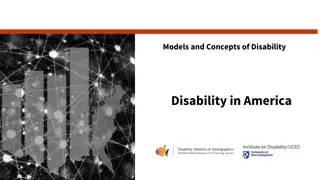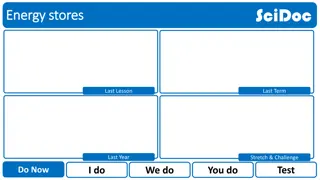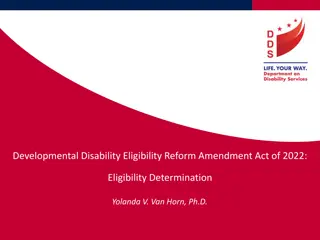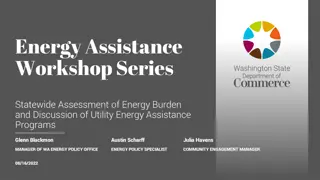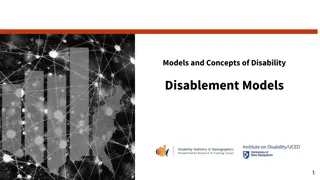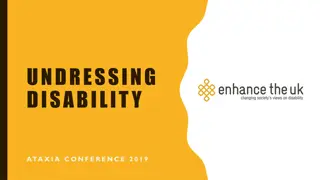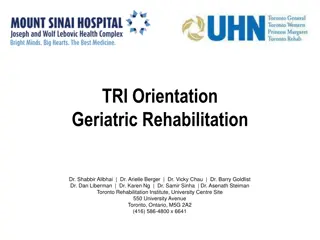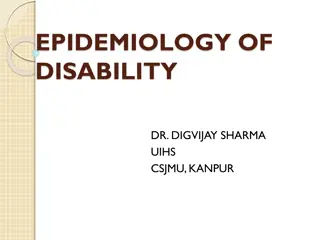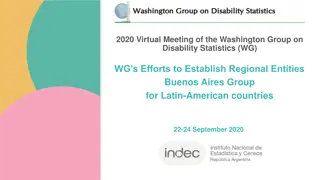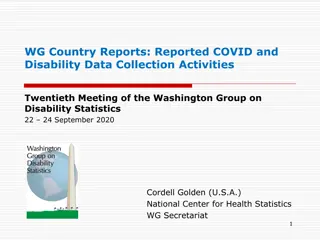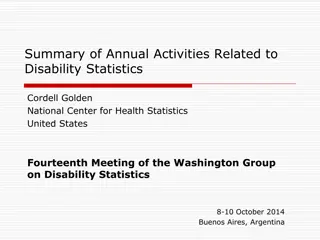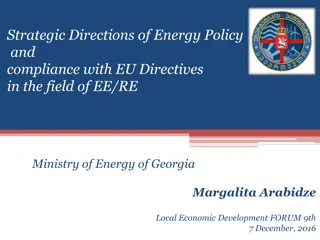Energy and Disability
Access to energy is crucial for persons with disabilities as they have higher energy needs. The use of assistive technologies and access to modern forms of energy are essential for independent living. However, a significant percentage of persons with disabilities living in developing countries lack access to affordable and modern energies, affecting their health and daily lives. Addressing the energy needs of persons with disabilities is vital for their inclusion and well-being in society.
Download Presentation

Please find below an Image/Link to download the presentation.
The content on the website is provided AS IS for your information and personal use only. It may not be sold, licensed, or shared on other websites without obtaining consent from the author.If you encounter any issues during the download, it is possible that the publisher has removed the file from their server.
You are allowed to download the files provided on this website for personal or commercial use, subject to the condition that they are used lawfully. All files are the property of their respective owners.
The content on the website is provided AS IS for your information and personal use only. It may not be sold, licensed, or shared on other websites without obtaining consent from the author.
E N D
Presentation Transcript
Energy and Disability 5th Expert Group Meeting on Monitoring and Evaluation for Disability-inclusive Development 13 December 2017 Sae Kajima Associate Social Affairs Officer Division for Social Policy and Development, UN-DESA
Disability and Energy : Why important? Access to energy is fundamental for development Persons with disabilities have higher energy needs Use of Assistive technologies for independent living Persons with mobility difficulties tend to spend long time at home Annual energy bills of families with persons with disabilities: 50% more than families without persons with disabilities* 80% of persons with disabilities live in developing countries and many use traditional forms of energy inside the houses that have negative impact on health -> Need access to modern forms of energies Many persons with disabilities live in low-income households -> Need access to affordable energy *Author s elaboration based on the three case studies. (George, M., et al. The Energy Penalty: disabled people and fuel poverty , University of Leicester (2013). Pp.27-34)
Situation of persons with disabilities: lower access to electricity at a glance Households with Electricity (%) 1991-2015 In 87% of countries, households with persons with disabilities have lower access to energy. 100% 90% 80% 70% 60% 50% For countries with less than 70% electricity access, gap between the two types of households increases 40% 30% 20% 10% 0% Zambia Brazil Jamaica Gambia Mozambique Vietnam PALESTINE Indonesia Morocco Ethiopia Botswana Bangladesh Kenya Burkina Faso Malawi Mexico Ecuador Uganda (2011) Uganda (2002) Liberia Trinidad and Tobago Saint Lucia Senegal Panama Maldives Jordan El Salvador Yemen Ghana Mali Cambodia Cambodia Uruguay Dominican Republic Tanzania Egypt Colombia (2015) Colombia (2005) Paraguay Sudan South Africa Cameroon Swaziland South Sudan Costa Rica Iran Households with person(s) with disabilities (%) Households without person(s) with disabilities (%) Source: Author s elaboration based on data collected by: the DHS (Demographic and Health Surveys, Funded by USAIDS), SINTEF (Norwegian: Stiftelsen for industriell of teknisk forskning) studies and IPUMS (Integrated Public Use Microdata Series, USA)
Situation of persons with disabilities: lower access to electricity in numbers 80% of the persons with disabilities live in developing countries* In Sub-Saharan Africa, only 47% of the total population had access to electricity in and only 27%in rural areas in that region (2014). ** In rural areas in the Pacific countries access is also low, with only 44% of the population having access to electricity. ** The low access to electricity will pose specific challenges to persons with disabilities who need electricity-run assistive technology devices to live independently and participate in society and development. Source: * **Sustainable Energy For All Initiative (2017). Global Tracking Framework 2017 Progress toward sustainable energy, Data Annex
Situation of persons with disabilities: Use of traditional forms of energy Households using solid fuels for cooking in 2010 (%) 100 80 77 60 61 40 46 14 35 20 7 0 sub-Saharan Africa Southeast Asia Western Pacific Region North Africa and Eastern Mediterranean region Americas Europe Source: S. Bonjour and others (2013). Solid fuel use for household cooking: country and regional estimates for 1980-2010. Environmental health perspectives, vol 121, p. 784-790.
Energy demand: Priority Assistive Products WHO Priority Assistive Products Fall Detectors GPS locators Recorders Hearing aids (digital) Personal digital assistant Examples: Canes/sticks Chairs for shower/bath/toilet Hand rails/grab bars Magnifiers (optical) Orthoses Prostheses Walking frames/walkers Wheelchairs (manual) Operates with electricity or disposable batteries, 28% No electricity nor batteries needed, 56% Braille displays (note takers) Screen readers Simplified mobile phones Wheelchairs (electrical) Requires electricity (incl. rechargeable batteries), 16% Source: WHO, 2016. Priority Assistive Products List
International Frameworks Target 7.1 Universal access to affordable, reliable and modern energy Target7.a By 2030, enhance international cooperation to facilitate access to clean energy research and technology, including renewable energy, energy efficiency and advanced and cleaner fossil-fuel technology, and promote investment in energy infrastructure and clean energy technology Target 7.b Expand infrastructure and upgrade technology for supplying modern and sustainable energy services for all in developing countries Art.19 (independent, inclusion) Art 20 (mobility) Art.26 (Habilitation and rehabilitation) Art.28 (adequate standard of living and social protection)
National Policies on disability and energy Many countries offer some sort of disability benefit but typically do not consider the additional energy costs faced by persons with disabilities. Social welfare programs directed at supporting the energy bills of persons disabilities do exist: Example: UK The Cold Weather Payment GBP25 per 7 days of cold weather to households (low income, persons with disabilities) The Warm Home Discount Scheme One-off discount of GBP140 on electricity bill to low income households Winter Fuel Payment GBP100-300 tax free on heating bills for older persons Example: US Low Income Home Energy Assistance Program (LIHEAP) Assists low-income households including persons with disabilities to pay electricity bills, energy crisis assistance, and weatherization and energy-related minor home repairs.
UN Initiatives on energy and disability Need to reach out to persons with disabilities In 2012, the GA declared 2014-2024 the Decade of Sustainable Energy for All (A/RES/67/215) Supported programmes expanding electricity services to 4,300 town and villages in Ethiopia A Public-Private partnership Minimum Electricity Access promotes access to affordable, reliable, and sustainable off-grid renewable energy system in rural areas. GA resolution on Ensuring access to affordable, reliable, sustainable and modern energy for all (A/RES/71/233) Reports of the Secretary-General on Ensuring access to affordable, reliable, sustainable and modern energy for all (A/72/160), United Nations Decade of Sustainable Energy for All (A/72/156) Persons with disabilities are not included
Recommendations 1) More studies needed on disability and energy. 2) Social protection measures need to consider the extra energy costs that persons with disabilities are faced with. 3) Development activities/programmes on enhancing energy access needs to include persons with disabilities. 4) Close gaps in electricity access between households with and without persons with disabilities. 5) Reduce use of solid fuels to prevent negative impact on health. 6) Focus on countries with low electricity access, especially sub-Saharan Africa.
We need your advice 1) More data, evidence, research on extra costs on electricity that are met by persons with disabilities? 2) More examples of social protection measures/programmes to financially support persons with disabilities on paying electricity bills? 3) More examples of projects on energy that reach out to persons with disabilities? 4) Data, evidence, research on electricity consumption of each assistive product?
THANK YOU! Sae Kajima Associate Social Affairs Officer Division for Social Policy and Development, UN-DESA Email: kajima@un.org
